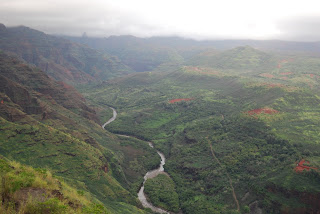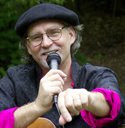

Hawaii: Australia Jan and February 2009:
Notes from a Planet in Peril
Preface:
A month away from Vermont and the US, in a time of great transitions: the global economy is sinking, Obama coming on and looking to save us, and we are off to Hawaii and Australia. I’m looking forward to leaving the cold paradise of Vermont.
Each journey holds a truth or awareness. What is the awareness I need? The trip is in part to perform in Hawaii and Australia (GOD SEX POLITICS 2009), to see the Australian Open, visit some friends in Melbourne, and gain an insight into a world I didn’t know before.
In witnessing scenes of incredible beauty from the interior of the Island of Kauai, playing guitar while watching sunrise over the Pacific, kayaking among the seals by Apollo Bay, snorkeling on the Great Barrier Reef, staying in the Daintree Rainforest, and visiting the parched and burning southern Australia, I was left with the story of a fragile planet in peril. Though there are great acts of personal ecological heroism: Are there enough to save the humans? Eventually humans will die out like the dinosaurs and it’s only a question of when. At the O’Hare airport in Chicago is a towering dinosaur skeleton and is that symbol trying to tell us something or merely a curious artifact? The important issue is – Will humans leave anything on the planet worth saving? Will it be an overheated radiological wasteland? As one science fiction writer said, “The last species on the planet will be a cockroach eating a fungus.” Actually it will be the bacteria in the cockroaches’ gut. Or, are we wise and courageous enough to step back from the abyss? As the world economy is going through a major meltdown, it is surprising there isn’t the insight that questions the validity of unbridled industrial activity and the constant expansion of the human population at the expense of our habitat.
Some years ago, bicycling through New York City at rush-hour in August and darting among the cars, I felt the intense heat from the buses and the cars; I didn’t need further evidence of global warming. Or, standing in Connaught Place in New Delhi at rush hour where you can’t see more than 10 meters in front of you because of the suffocating cloud of two cycle engine fumes. It is a hot and crowded planet.
Though I had been on a newspaper “fast” I would occasionally read the headlines: Cholera kills 3,000 in Zimbabwe; the Israeli Army kills 900 civilians; forest fire kills 175 people in Melbourne; and this is only the tip of what goes on a regular basis. Maybe newspaper headlines are really homage to a dying planet? Each headline an epitaph
or is it an epithet? Though individual acts of courage like the Sea Shepherd trying to stop the Japanese whaling ship is laudable and necessary, it highlights the global ecological collapse as Japan has virtually over fished its costal waters. I wish I could see some kind of positive affirmation or that humans have gained some kind of insight, but I only see the brutal tragedy of a species, Homo-sapiens, that has gone mad; perhaps the new designation is Homo-locust, a spreading invasive disease that complete destroys its environment. In the midst of this ecological suicide I will tell you these things that I do find glorious and awe inspiring. If we were awed by the miracle of life, spell-bound by the presence of a drop of water, savored a full breath as if it were our last, astonished by the magnificence of a tree, and realized that paradise is not in the next life, but here, present and alive, this is heaven. Can you see it too?
Kauai: Capricious Lady
In Kauai, a twenty minute plane ride from Oahu is the stunning beauty of a volcanic island verdant from the tropical rains that seem to come and go throughout the day with such regularity. Though much of the vegetation from the coconuts, palms, and grasses have been brought in by settlers both Polynesian and others, Kauai remains the quintessential paradise, lush forests, skies that are crisp and clear, and then darken over for a rain shower. The clouds and the skies of Kauai in January are a constant shifting of light, colors, and moods. Sunlight and rain dance throughout the day, a rain shower gives way to an inundation, and then a glorious moment of light.
At 5 am, the moon and stars over the Pacific brightly illuminate the ocean, splashes of near phosphorescent light as the surf pounds against the volcano rocks on the shore. Standing on the promontory of Poipu beach, the night sky is vivid, and the sun’s first light creeps from the East. The ocean is an interplay of light and colors, clouds refracting moon-light, tides swell and a chorus of waves breaks across the shore. The wind roars through the grasses and the tall coconuts, and faintly the call of birds join in the symphony. A small sail boat, a kilometer off shore, with orange striped sails skips across the water. A red headed and white bodied British cardinal searches for food on the beach and white herons in the tide pools hop along the shore. The moon refuses to surrender to the advancing day, growing more ghostly, while the Northern star remains constant. Daybreak is insistent that it will be even more magnificent than the night; it comes to life with ruddy reds and mango yellows that are as luscious as the fruit. The steady tide, the fair wind from the North promises a good day of sun, and the slender possibility that the sun showers will be brief.
There is an easy indolence to the day, my lethargy grows, and I can barely find the energy to move or write. I am astonished by the symphony of color, light, sound and the smell of the ocean as it fills all of my senses. After god created this, did she lie back in the hammock with a marguerita, and admire it as much as I do?
Most of the beaches on the island are for resorts, condominiums, or some kind of over priced development. But there are public beaches where you always find Hawaiian families. The tremendous injustice is that native islanders can’t afford to own or live on the beach, though the beach is integral to Hawaii life and culture. One local girl showed us the creatures in the tide pools, the Spanish Dancer; a red jelly fish did a swirling flamenco dance for us in the pool.
Most of the local people we encounter are a mix of many different cultures – Filipino, Chinese, Polynesian, and White and so on. There are some old hippies we have run into who came to the island decades ago and have found a niche as shopkeeper, musician, or something that sustains them without a considerable effort. Kauai is inundated with Californians who don’t mind the five hour flight to their second home or retirees who live in gated enclaves: Gated communities – reservations for white people.
Though we would like to think of Hawaii as an ecological paradise, the thousand years of Polynesian and Hawaiian influence had caused ecological destruction before the white colonialists, but the far greater destruction has been due to the vast cattle and sugar cane plantations, the influx of tourism, development and population growth. On Poipu, our hotel occupies about a kilometer of shore line, volcanic rocks line the beach, and closely cropped lawns as uniform as astro-turf. The gardeners spend their day making sure the lawns, a precise shade of green due to chemicals and pesticides, are free from coconut fronds and debris. Though ecological tourism, with low impact housing, is a step in the right direction, the tourist industry that economically sustains the island will be part of its demise.
I don’t know how to minimize or mitigate than? Travel less? Travel with a backpack and walk everywhere? Or stay home? Is the far safer and saner to walk or bike everywhere? Get rid of the cars, ride on trains, or sit quietly in your backyard? Move to Europe or an urban center where you don’t need a car? This question or awareness of global destruction is ever present on our trip. Sitting at Joe’s Restaurant at one of the public golf courses with its18 holes golf course of trim uniform grass, but the ever present monoculture and insistence that nature conform to mankind’s narrow aesthetic guarantees an ecological suicide. Yet, as I am leaving Kauai, I value the immense beauty of the island, and hope that there is a collective wisdom that can keep this paradise for generations to come.
The Daintree Rainforest to Follow

No comments:
Post a Comment